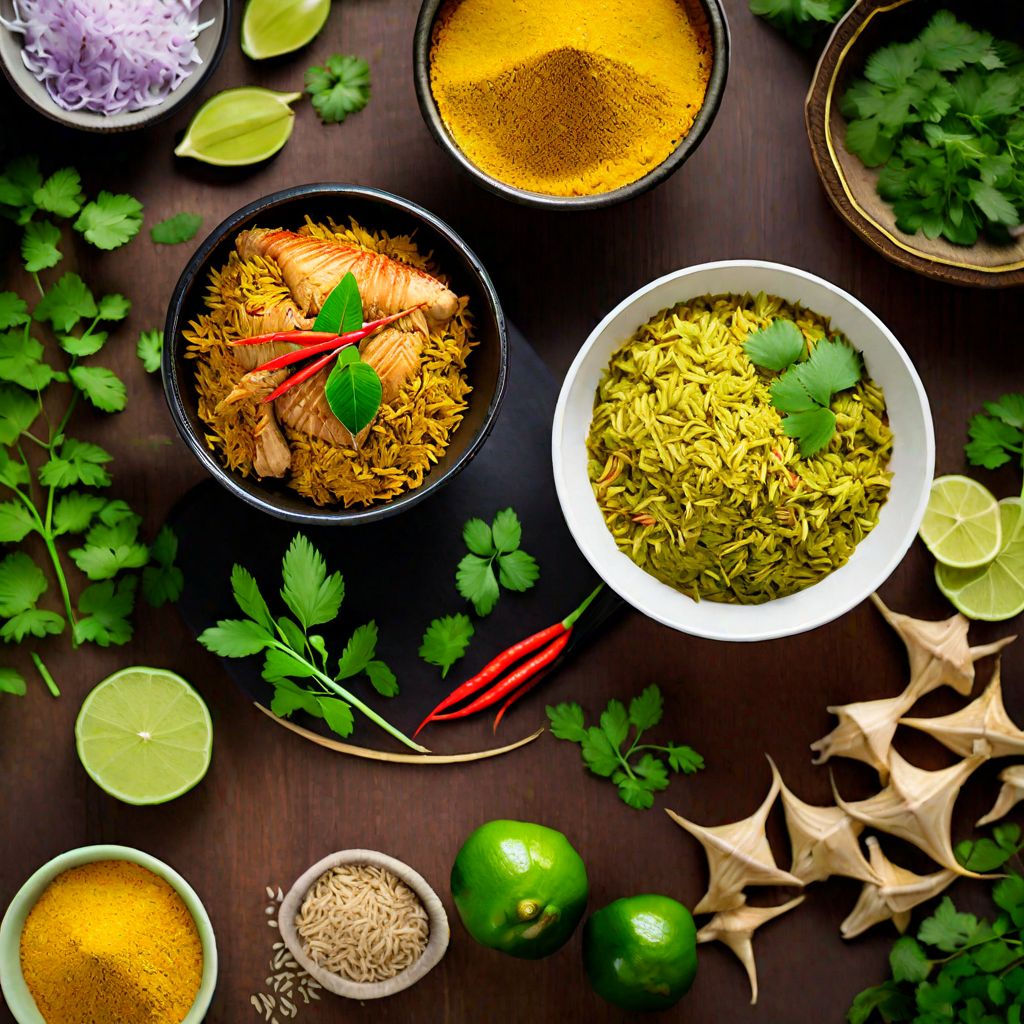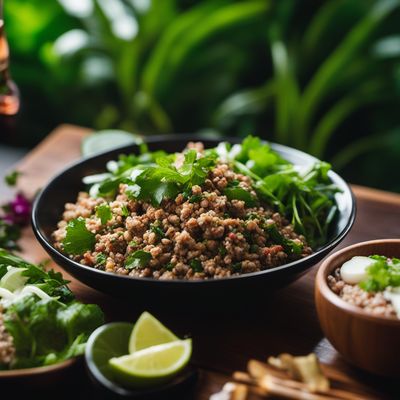
Recipe
Thai-style Biryani
Thai-inspired Fragrant Rice Delight
4.9 out of 5
In Thai cuisine, fragrant rice dishes are a staple. This Thai-style Biryani combines the aromatic flavors of Thai herbs and spices with the traditional Indian biryani technique. The result is a delightful fusion of two culinary worlds, creating a unique and flavorful dish that will transport your taste buds to the vibrant streets of Thailand.
Metadata
Preparation time
20 minutes
Cooking time
30 minutes
Total time
50 minutes
Yields
4 servings
Preparation difficulty
Medium
Suitable for
Gluten-free, Dairy-free, Nut-free, Low-carb, High-protein
Allergens
N/A
Not suitable for
Vegan, Vegetarian, Paleo, Keto, Halal
Ingredients
While the original Indian Biryani is known for its rich and spicy flavors, this Thai-style adaptation incorporates the fragrant and aromatic elements of Thai cuisine. The spices used are more subtle, with a focus on herbs like lemongrass, kaffir lime leaves, and Thai basil. Additionally, Thai-style Biryani uses jasmine rice instead of basmati rice, giving it a distinct Thai touch. We alse have the original recipe for Biryani, so you can check it out.
-
2 cups (470ml) jasmine rice 2 cups (470ml) jasmine rice
-
1 lb (450g) chicken, cut into pieces 1 lb (450g) chicken, cut into pieces
-
2 tablespoons vegetable oil 2 tablespoons vegetable oil
-
1 onion, thinly sliced 1 onion, thinly sliced
-
3 cloves garlic, minced 3 cloves garlic, minced
-
1 thumb-sized piece of ginger, grated 1 thumb-sized piece of ginger, grated
-
2 stalks lemongrass, bruised 2 stalks lemongrass, bruised
-
4 kaffir lime leaves 4 kaffir lime leaves
-
1 tablespoon Thai green curry paste 1 tablespoon Thai green curry paste
-
1 teaspoon turmeric powder 1 teaspoon turmeric powder
-
1 teaspoon cumin powder 1 teaspoon cumin powder
-
1 teaspoon coriander powder 1 teaspoon coriander powder
-
1 cup (240ml) coconut milk 1 cup (240ml) coconut milk
-
1 cup (240ml) chicken broth 1 cup (240ml) chicken broth
-
1 tablespoon fish sauce 1 tablespoon fish sauce
-
1 tablespoon soy sauce 1 tablespoon soy sauce
-
1 tablespoon lime juice 1 tablespoon lime juice
-
Fresh Thai basil leaves, for garnish Fresh Thai basil leaves, for garnish
-
Sliced cucumber and lime wedges, for serving Sliced cucumber and lime wedges, for serving
Nutrition
- Calories (kcal / KJ): 450 kcal / 1884 KJ
- Fat (total, saturated): 15g, 6g
- Carbohydrates (total, sugars): 50g, 2g
- Protein: 25g
- Fiber: 2g
- Salt: 1.5g
Preparation
-
1.Rinse the jasmine rice under cold water until the water runs clear. Drain and set aside.
-
2.In a large pot, heat the vegetable oil over medium heat. Add the sliced onion and cook until softened and lightly browned.
-
3.Add the minced garlic, grated ginger, lemongrass, and kaffir lime leaves to the pot. Cook for 1-2 minutes until fragrant.
-
4.Add the chicken pieces to the pot and cook until browned on all sides.
-
5.Stir in the Thai green curry paste, turmeric powder, cumin powder, and coriander powder. Cook for another minute.
-
6.Add the rinsed jasmine rice to the pot and stir well to coat the rice with the spices.
-
7.Pour in the coconut milk, chicken broth, fish sauce, soy sauce, and lime juice. Stir to combine.
-
8.Bring the mixture to a boil, then reduce the heat to low. Cover the pot and let the rice simmer for 15-20 minutes, or until the rice is cooked and the liquid is absorbed.
-
9.Remove the pot from the heat and let it sit, covered, for 5 minutes.
-
10.Fluff the rice with a fork and remove the lemongrass stalks and kaffir lime leaves.
-
11.Serve the Thai-style Biryani garnished with fresh Thai basil leaves. Accompany with sliced cucumber and lime wedges.
Treat your ingredients with care...
- Jasmine rice — Rinse the rice thoroughly to remove excess starch before cooking.
- Lemongrass — Bruise the lemongrass stalks by lightly pounding them with a rolling pin to release their flavor.
- Thai green curry paste — Adjust the amount according to your desired level of spiciness.
- Kaffir lime leaves — Tear the leaves slightly before adding them to the dish to release their aroma.
- Thai basil — Use fresh Thai basil leaves for the best flavor. If unavailable, regular basil can be used as a substitute.
Tips & Tricks
- For a vegetarian version, replace the chicken with tofu or mixed vegetables.
- Add a handful of cashew nuts or peanuts for extra crunch and flavor.
- Serve the Thai-style Biryani with a side of spicy Thai chili sauce for an added kick.
- To make it more fragrant, toast the spices before adding them to the dish.
- Experiment with different Thai herbs and spices to customize the flavors to your liking.
Serving advice
Serve the Thai-style Biryani hot, garnished with fresh Thai basil leaves. Accompany it with sliced cucumber and lime wedges for a refreshing touch. This dish pairs well with a side of spicy Thai chili sauce for those who enjoy an extra kick of heat.
Presentation advice
To enhance the presentation, serve the Thai-style Biryani in individual bowls or on a large platter. Garnish with a sprig of fresh Thai basil and place lime wedges and cucumber slices on the side. The vibrant colors and aromatic aroma will make this dish visually appealing.
More recipes...
For Biryani » Browse all
For Indian cuisine » Browse all
More Indian cuisine dishes » Browse all

Kallappam
Kallappam is a South Indian pancake made with fermented rice batter and coconut milk. It is a popular breakfast dish in Kerala and is often served...

Dahi puri
Dahi puri is a popular Indian street food that is made with crispy puris, potatoes, and yogurt.

Kathi Roll
Kathi roll
Kathi Roll is a popular street food in India that is perfect for a quick lunch or snack.
More Thai cuisine dishes » Browse all

Larb
Larb is a traditional Laotian dish made from minced meat, herbs, and spices. It is typically served with sticky rice and lettuce leaves.

Khanom chin nam ya
Thai Rice Noodles with Fish Curry
Khanom chin nam ya is a traditional Thai dish made with rice noodles and fish curry. It is a popular street food in Thailand and is known for its...

Yam khai dao
Thai Egg Salad
Yam khai dao is a traditional Thai salad that is made with crispy fried eggs. It is a refreshing and light dish that is perfect for summer.











